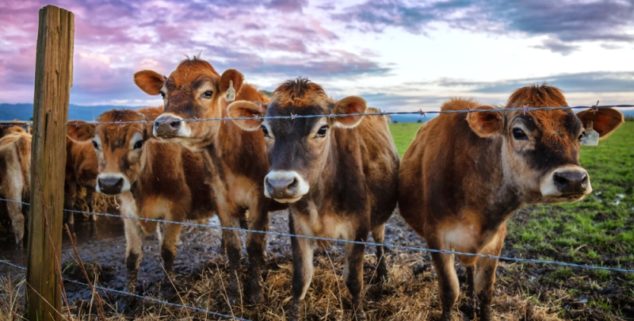Opinion
Federal Ag Department’s climate-smart funding fails the grade
 Friendly cows say hello at sunset on a northern California ranch. (Photo: Jeffrey Schwartz, via Shutterstock)
Friendly cows say hello at sunset on a northern California ranch. (Photo: Jeffrey Schwartz, via Shutterstock)President Biden’s Department of Agriculture surprised everyone this week by announcing it would triple expectations for funding the Partnerships for the Climate-Smart Commodities Program.
The announcement seemed like a welcome signal that the administration’s getting serious about tackling agricultural emissions. But without evidence of a science-driven review process, it’s not clear how smart the “climate-smart” plan really is.
Dairy products (milk, cheese, ice cream and yogurt) contribute a significant amount of annual global emissions.
A closer look shows most of the $2.8 billion will likely line the pockets of the biggest climate polluters in agriculture. Rather than addressing Biden’s call to mitigate greenhouse gases and break up the monopolies dominating corporate agriculture, the USDA is ignoring climate science by boosting the most harmful sectors in this industry.
The Climate-Smart Commodities program includes funding to giant corporate entities with enormous climate footprints. That includes $90 million dollars to Archer Daniels Midland, $85 million to the California Dairy Research Foundation, $60 million dollars to Tyson Foods, $50 million to Edge Dairy Farmer Collective, and $45 million to Dairy Farmers of America.
In the carveout to Dairy Farmers of America, for example, USDA notes climate-smart pilots will connect with “low-carbon dairy market.” This is like saying “clean coal” will connect with “low-impact” fossil fuel extraction. (In fact, an additional $30 million will be directed to Gevo, Inc. to “accelerate the production of sustainable aviation fuel” by producing even more corn, which some read as another subsidy for the extreme pollutant ethanol.)
Dairy is an emissions-intensive form of agriculture. A report published in the journal Climate Policy noted that dairy products (milk, cheese, ice cream and yogurt) contribute a significant amount of annual global emissions. At 3.6%, the impact of dairy on the climate hovers somewhere between the CO2 emissions budgets of the United Kingdom and Germany. That’s a significant piece of the pie for a single food group. The Environmental Protection Agency notes that animal agriculture is a leading source of domestic methane, much of which comes from cattle producing beef and dairy.
Funneling even more cash to the biggest dairy corporations comes as demand declines. In the United States, people are drinking less liquid milk. Yet the industry is bailed out by the federal government, which subsidizes the overproduction ofmilk and cheese and then spends millions of dollars to buy back surplus dairy — despite the serious impact of dairy production on the environment and climate. The answer to declining demand for a harmful product (that much of the population can’t even digest) isn’t to throw it a lifeline but to establish a just transition for agriculture.
While U.S. demand for dairy declines, the market for dairy exports is growing in Europe and beyond. At the COP-26 global conference on climate change last fall, USDA chief Tom Vilsack, a former dairy lobbyist, insisted that Americans did not have to eat less meat and dairy to mitigate climate change, noting “a significant percentage is exported.”
Low emissions agriculture means shifting away from the biggest emitters, not funding the expansion of those high-emissions industries by funneling more money to industry friends. A smarter climate-driven effort would be to help mitigate demand by reducing overproduction.
Meanwhile, under Vilsack’s leadership, the USDA has indicated an intention to break up corporate monopolies and enforce antitrust laws governing the meat industry. So far Secretary Vilsack has rested on voluntary climate initiatives and “net zero” measures that have been critiqued by climate scientists for distorting emissions and making corporate commitments seem more effective than they are.
Giving billions of dollars to the worst climate polluters contradicts the Biden administration’s call to action to address climate change as an existential crisis. Funding directed toward Tribal organizations, historically marginalized farmers of color, and small and independent farms is a key part of climate justice and a more sustainable system. But these entities, by and large, are not leading the partnership programs.
The biggest climate polluters in farming, such as dairy, are generally the industries that also most water-intensive, use the most land, create the most manure pollution, are the least drought-resistant or heat tolerant, and whose products are the least shelf-stable. As climate-smart, resilient commodities they don’t make the grade.
—
Editor’s Note: Jennifer Molidor is senior food campaigner at the Center for Biological Diversity.
Want to see more stories like this? Sign up for The Roundup, the free daily newsletter about California politics from the editors of Capitol Weekly. Stay up to date on the news you need to know.
Sign up below, then look for a confirmation email in your inbox.

Leave a Reply